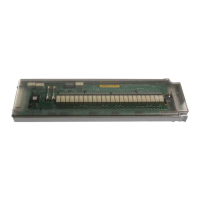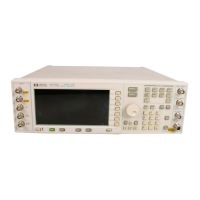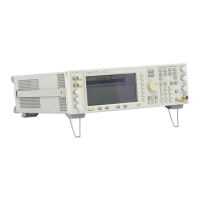1-106
Troubleshooting
RF Path Description (Frequency Generation, Level Control, and Modulation)
<3.2 GHz Fast Pulse Modulator (Option 1E6)
Option 1E6 provides improved pulse performance below 3.2 GHz. This option is installed in the
lowband path between the A8 Output and the A23 Lowband Coupler Detector. The pulse drive
signal is electrically switched from the A8 Output to the 1E6 assembly, and the pulse diode on the
A8 Output is biased on, allowing the RF signal to pass through.
A35 3–20 GHz I/Q Modulator (Vector Models Only)
The I/Q Modulator, installed between the A28 20 GHz Doubler and the A30 Mod Filter, adds I/Q
information to the RF signal. The I/Q Modulator provides the 90° delay circuitry required for I/Q
modulation. Inputs to the A35 3–20 GHz I/Q Modulator are from the A13 I/Q Multiplexer. The
multiplexer receives inputs from the External I/Q Mod inputs and, if installed, the Option 002/602
Baseband Generator.
ALC Loop
The ALC loop maintains power level control and power level accuracy. Level accuracy is achieved by
converting a portion of the RF signal to dc, comparing the measured dc to a reference dc voltage,
integrating the difference, and using the integrated output to drive the ALC modulation diode.
Level control is achieved by adjusting the reference voltage.
The A23 Lowband Coupler/Detector and the A24 Highband Coupler and A25 Highband Detector
couple off RF signal and convert it to a dc voltage. Because the coupled signal is a known ratio of the
RF output power, it can be used to control the RF output level. On the A10 ALC assembly, the dc is
compared to a reference voltage, integrated, and the integrated voltage used to drive the modulator
diodes on the A8 Output and A30 Modulation Filter. Temperature sensing circuits maintain level
correction over the specified temperature range. In sweep mode, additional compensation is applied
to the ALC from the A9 YIG Driver to maintain power flatness during sweep.
A10 ALC
The A10 ALC assembly provides circuitry for level control and amplitude modulation. In ALC On
operation (closed-loop operation), the output signal level is continually monitored and used to adjust
the modulator diode output to produce the desired RF output level. In ALC On operation, the A10
ALC integrates the difference between the detected voltage and the reference voltage to adjust the
modulator diode drive until both voltages agree. The A23 Lowband Coupler/Detector and A24
Highband Coupler and A25 Highband Detector provide the feedback (detected DC) voltage to the
A10 ALC. On the A10 ALC, the reference voltage is generated by DACs that are controlled by the
CPU. The DACs output voltage is calibrated to the RF output power level.
In ALC Off mode (open-loop operation) the feedback path (the RF detected voltage path) is opened,
and only the reference voltage is used to set the output power level. With the modulator reference
level set to a fixed drive level, and without the output level being monitored, the RF output level can
vary from the set power level. In open-loop, the power level can also drift over time with changes in
temperature.
In external leveling operation, the internal detectors are replaced with an external detector,
replacing the internal detectors’ voltage with the external detector’s voltage. The external detector
must be a negative detector to provide the correct polarity for the A10 ALC. In standard
instruments, the external leveling operating range is option-dependent, but is either –20 dBm or
–15 dBm to maximum power.

